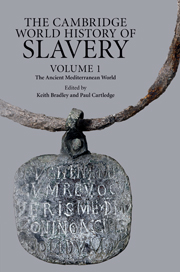Book contents
- Frontmatter
- Contents
- Series editors' introduction
- List of figures
- Acknowledgements
- Introduction
- 1 Slavery in the ancient Near East
- 2 Slaves in Greek literary culture
- 3 Classical Athens
- 4 The Helots: a contemporary review
- 5 Slavery and economy in the Greek world
- 6 The slave supply in classical Greece
- 7 Slavery and the Greek family
- 8 Resistance among chattel slaves in the classical Greek world
- 9 Archaeology and Greek slavery
- 10 Slavery in the Hellenistic world
- 11 Slavery and Roman literary culture
- 12 Slavery in the Roman Republic
- 13 Slavery Under the Principate
- 14 The Roman slave supply
- 15 Slave labour and Roman society
- 16 Slavery and the Roman family
- 17 Resisting slavery at Rome
- 18 Slavery and Roman material culture
- 19 Slavery and Roman law
- 20 Slavery and the Jews
- 21 Slavery and the rise of Christianity
- 22 Slavery in the late Roman world
- Bibliography
- General index
- Index of ancient passages cited
- Index of inscriptions and papyri
- Index of Jewish and Christian Literature Cited
10 - Slavery in the Hellenistic world
Published online by Cambridge University Press: 28 September 2011
- Frontmatter
- Contents
- Series editors' introduction
- List of figures
- Acknowledgements
- Introduction
- 1 Slavery in the ancient Near East
- 2 Slaves in Greek literary culture
- 3 Classical Athens
- 4 The Helots: a contemporary review
- 5 Slavery and economy in the Greek world
- 6 The slave supply in classical Greece
- 7 Slavery and the Greek family
- 8 Resistance among chattel slaves in the classical Greek world
- 9 Archaeology and Greek slavery
- 10 Slavery in the Hellenistic world
- 11 Slavery and Roman literary culture
- 12 Slavery in the Roman Republic
- 13 Slavery Under the Principate
- 14 The Roman slave supply
- 15 Slave labour and Roman society
- 16 Slavery and the Roman family
- 17 Resisting slavery at Rome
- 18 Slavery and Roman material culture
- 19 Slavery and Roman law
- 20 Slavery and the Jews
- 21 Slavery and the rise of Christianity
- 22 Slavery in the late Roman world
- Bibliography
- General index
- Index of ancient passages cited
- Index of inscriptions and papyri
- Index of Jewish and Christian Literature Cited
Summary
INTRODUCTION
When Alexander of Macedon conquered the former Persian empire in the last third of the fourth century bc, the different forms of dependence that he found there seem likely to have exceeded those familiar to the Greek world from which he came. Following this conquest much was left in place, but the spread of Greek-style chattel slavery represented a real change in the Hellenistic world. While attempting, therefore, to place chattel slavery within a wider context of dependence, this chapter will in part be concerned with one particular aspect of the impact of Greek rule on new areas of the East – the introduction of chattel slavery to areas where previously it had not formed part of the culture. The geographical scope of this inquiry is of necessity wide, since the new Greek-speaking world stretched from Sicily in the west to Afghanistan and the bounds of India in the east. The old world of mainland Greece, the islands of the Aegean and the coasts of Asia Minor and the Black Sea remain relevant, but changes there were of lesser note than those in the new Macedonian kingdoms of the East – in Seleucid Asia, Attalid Pergamum and Ptolemaic Egypt. From Egypt, papyri preserved in the dry desert sands provide an ever-expanding source of information on the role played by slavery in at least this one of the Hellenistic kingdoms.
- Type
- Chapter
- Information
- The Cambridge World History of Slavery , pp. 194 - 213Publisher: Cambridge University PressPrint publication year: 2011
- 6
- Cited by

